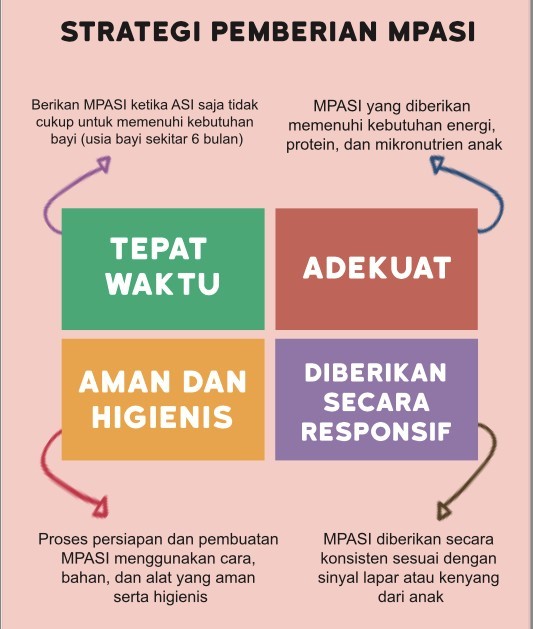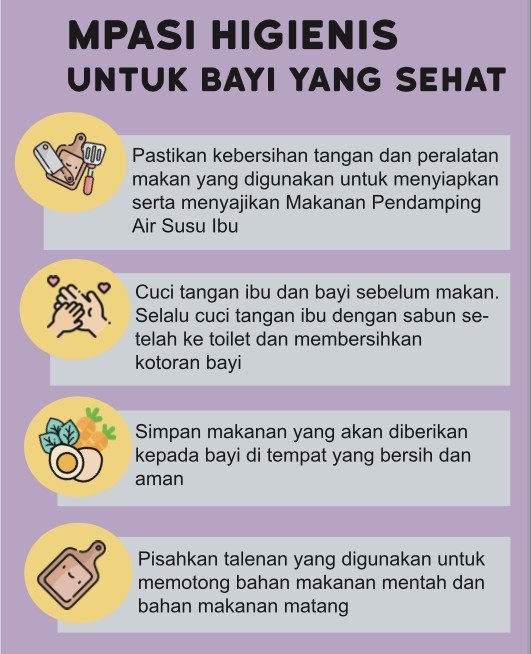
“Doctor, Complementary Food – ASI, how do you give it? Can my child be introduced to MPASI? I start with bananas, how do you dock?” Questions that are routinely asked by fathers and mothers when their children turn 5-6 months old. So, let's discuss tips on giving MPASI.
Before starting to give complementary foods, health workers need to assess the baby's readiness based on oromotor development, namely: can sit with his head straight, can coordinate eyes, hands and mouth to receive food, is interested in food, and is able to swallow solid food. Naturally, this ability is achieved at the age of 4-6 months.

"My child already looks like the criteria above Doc, what next? “
WHO Global Strategy for Feeding Infants and Young Children in 2003 recommended that complementary feeding meet 4 conditions, namely:
1. On time ( timely )
meaning that complementary foods are given when exclusive breastfeeding is no longer able to meet the nutritional needs of the baby. At the age of 6 months, breast milk is not able to meet the nutritional needs for the growth and development of the baby.
Breast milk is no longer able to meet the needs for energy, protein, iron, vitamin D, zinc, and vitamin A, so complementary foods are needed to supplement the deficiency of macro and micro nutrients.
Even though it is unable to fully meet the nutritional needs, breastfeeding is still recommended because compared to infant formula, breast milk contains functional substances such as immunoglobulins, hormones, oligosaccharides, and others that are not present in infant formula.
Age 6-9 months is a critical period to introduce solid foods gradually as stimulation of oromotor skills. If at the age of 9 months you have never been introduced to solid food, then you are likely to experience eating problems when you are a toddler.
2. Adequate
meaning that MPASI contains macronutrients and micronutrients for babies according to macronutrient intake including carbohydrates, protein and fat; while micronutrients include vitamins, iron, zinc, magnesium, sodium, etc. Anemia due to iron deficiency has been shown to reduce IQ scores by 10-15 points. Deficiency of some micronutrients such as zinc, potassium and magnesium can reduce levels of growth factor (IGF1) which results in stunting (short stature due to lack of nutrients).
Golden period or what is known as the first 1000 days of a baby's life is the most important period, in which babies experience rapid brain, muscle and skeletal development. Some essential nutrients (which must be obtained from food) such as amino acids and iron are needed in the formation of synapses and neurotransmitters which affect the speed of thinking, which in turn will affect the quality of life of children.

3. Safe
meaning that MPASI is prepared and stored in a hygienic way, given using clean hands and cutlery. To ensure the cleanliness and safety of the food consumed by children, do the following: wash your hands before eating, use clean and sterile cutlery, cook food properly, avoid mixing raw food with cooked food, wash vegetables and fruit before eating, use a clean water source, and store food in a safe place.
4. Provided in the right way ( properly fed )
meaning that MPASI is given by paying attention to a child's hunger and fullness signals (responsive feeding). The frequency of meals and the method of feeding must be able to encourage children to actively consume food in sufficient quantities using hands, spoons, or self-feeding (adjusted to the age and developmental stage of a child).
In the first year, babies and parents learn to recognize each other and interpret the language of verbal and non-verbal communication between them. This reciprocal process forms the basis for the emotional bond or attachment between infant and parent which is essential for the development of healthy social-emotional functioning. The baby will show signs of hunger and fullness with his body language ( feeding cue ). If the mother pays attention to the feeding cues from her baby and gives breast milk according to these signs, a feeding schedule will be created that is most suitable for the baby which is different from other babies.
The attitude of the mother/caregiver who is responsive to this sign is called responsive feeding . Responsive feeding according to WHO includes:
- Direct feeding of infants by caregivers and assistance for older children who eat alone.
- Be sensitive to signs of hunger and satiety shown by babies / toddlers.
- Give food slowly and patiently.
- Encourage children to eat without coercion.
- Try different combinations of foods, flavors, textures and ways to get your child to accept them if they refuse many kinds of food.
- As few distractions during meals as possible if the child is easily distracted while eating.
- Mealtime is a period of learning, giving affection including talking to the child with eye contact.
Do you understand, father and mother? It's definitely not easy, but you have to believe that you can! Good luck..
Article written by dr. Messia Paramita, Sp.A,M.Sc (Child Specialist at EMC Sentul Hospital).
